stop start YAMAHA FZR 2015 Owners Manual
[x] Cancel search | Manufacturer: YAMAHA, Model Year: 2015, Model line: FZR, Model: YAMAHA FZR 2015Pages: 104, PDF Size: 4.29 MB
Page 5 of 104

Table of contents
General and important labels ........... 1
Identification numbers .................... 1
Primary Identification (PRI-ID)
number............................................ 1
Craft Identification Number (CIN) ....... 1
Engine serial number.......................... 1
Manufactured date label .................... 2
Model information ........................... 2
Builder’s plate .................................... 2
Important labels .............................. 4
Warning labels.................................... 5
Other labels ........................................ 9
Safety information ........................... 11
Limitations on who may operate
the watercraft ............................. 11
Cruising limitations ........................ 12
Operation requirements ................ 13
Recommended equipment ........... 15
Hazard information........................ 16
Watercraft characteristics ............. 16
Safe boating rules ......................... 18
Enjoy your watercraft
responsibly ................................. 18
Description....................................... 20
Watercraft glossary ....................... 20
Location of main components ...... 21
Control function operation ............. 25
Watercraft control functions ......... 25
Remote control transmitter .............. 25
Yamaha Security System ................. 26
Engine stop switch .......................... 27
Engine shut-off switch .................... 27
Start switch ..................................... 27
Throttle lever .................................... 28
Steering system ............................... 28
Telescopic steering system.............. 29
Cooling water pilot outlets ............... 29
Water separator................................ 30
Watercraft operation ...................... 31
Watercraft operation functions ..... 31
Reverse system ................................ 31
Quick Shift Trim System
(Q.S.T.S.) ....................................... 32
Watercraft operation modes ......... 33
Low RPM Mode ............................... 33
Instrument operation ...................... 35
Dual analog meter unit.................. 35
Speedometer.................................... 35
Tachometer ...................................... 35
Information display ........................... 36
Equipment operation ...................... 40
Equipment..................................... 40
Seats ................................................ 40
Reboarding grip................................ 41
Reboarding step ............................... 41
Bow eye............................................ 42
Stern eyes ........................................ 42
Storage compartments .................... 42
Fire extinguisher holder and cover ... 45
Operation and handling
requirements ................................... 47
Fuel requirements ......................... 47
Fuel................................................... 47
Engine oil requirements ................ 49
Engine oil .......................................... 49
Draining the bilge water ................ 50
Draining the bilge water on land....... 50
Draining the bilge water on water .... 51
Transporting on a trailer................ 52
First-time operation ........................ 53
Engine break-in............................. 53
Pre-operation checks ..................... 54
Pre-operation checklist .................... 54
Pre-operation check points .......... 56
Pre-launch checks ........................... 56
Post-launch checks.......................... 63
UF3L71E0.book Page 1 Monday, June 30, 2014 9:06 AM
Page 6 of 104

Table of contents
Operation ......................................... 65
Operating your watercraft ............. 65
Getting to know your watercraft ...... 65
Learning to operate your
watercraft ...................................... 65
Riding position ................................. 66
Launching the watercraft ................. 66
Starting the engine on water ............ 66
Stopping the engine ......................... 67
Leaving the watercraft...................... 67
Operating the watercraft .................. 67
Turning the watercraft ...................... 68
Stopping the watercraft ................... 69
Operating the watercraft in
reverse .......................................... 70
Boarding the watercraft ................... 70
Starting off........................................ 73
Capsized watercraft ......................... 74
Beaching and docking the
watercraft ...................................... 75
Operating in weeded areas .............. 75
After removing the watercraft from
the water ....................................... 76
Care and storage............................. 77
Post-operation care ...................... 77
Flushing the cooling water
passages....................................... 77
Cleaning the watercraft .................... 78
Battery care ...................................... 78
Long-term storage ........................ 81
Cleaning ........................................... 81
Lubrication ....................................... 81
Rustproofing..................................... 82
Maintenance .................................... 83
Maintenance.................................. 83
Tool kit.............................................. 83
Removing and installing the engine
cover ............................................. 83
Periodic maintenance chart ............. 85
Engine oil and oil filter ...................... 87
Specifications .................................. 88
Specifications ............................... 88
Trouble recovery ............................. 89
Troubleshooting ............................ 89
Troubleshooting chart ...................... 89
Emergency procedures ................ 92
Cleaning the jet intake and
impeller ......................................... 92
Jumping the battery ......................... 93
Replacing the fuses .......................... 93
Towing the watercraft....................... 95
Submerged watercraft ..................... 95
Index................................................. 96
UF3L71E0.book Page 2 Monday, June 30, 2014 9:06 AM
Page 29 of 104
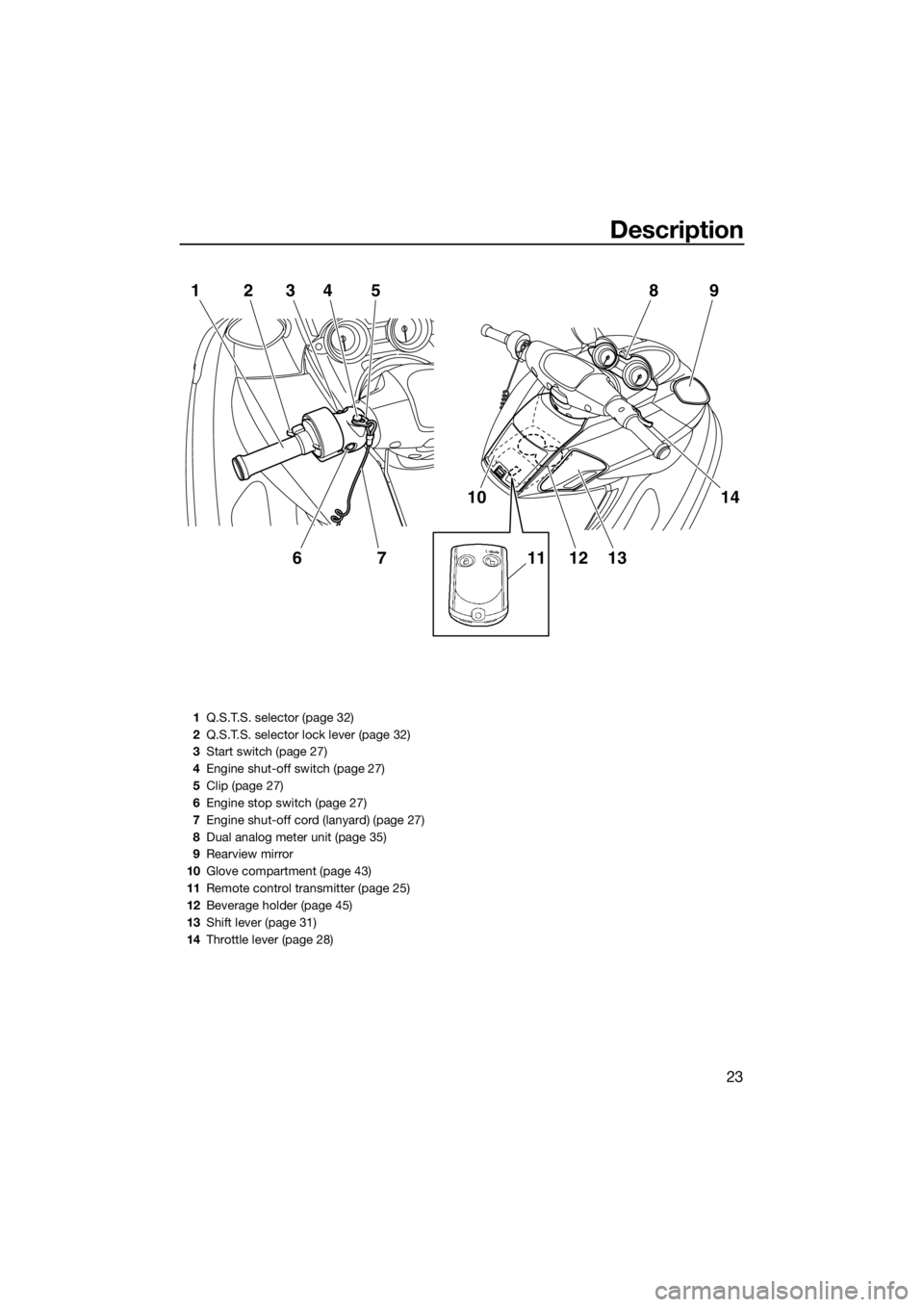
Description
23
1234
675
10
1112 1314 9 8
1Q.S.T.S. selector (page 32)
2Q.S.T.S. selector lock lever (page 32)
3Start switch (page 27)
4Engine shut-off switch (page 27)
5Clip (page 27)
6Engine stop switch (page 27)
7Engine shut-off cord (lanyard) (page 27)
8Dual analog meter unit (page 35)
9Rearview mirror
10Glove compartment (page 43)
11Remote control transmitter (page 25)
12Beverage holder (page 45)
13Shift lever (page 31)
14Throttle lever (page 28)
UF3L71E0.book Page 23 Monday, June 30, 2014 9:06 AM
Page 32 of 104
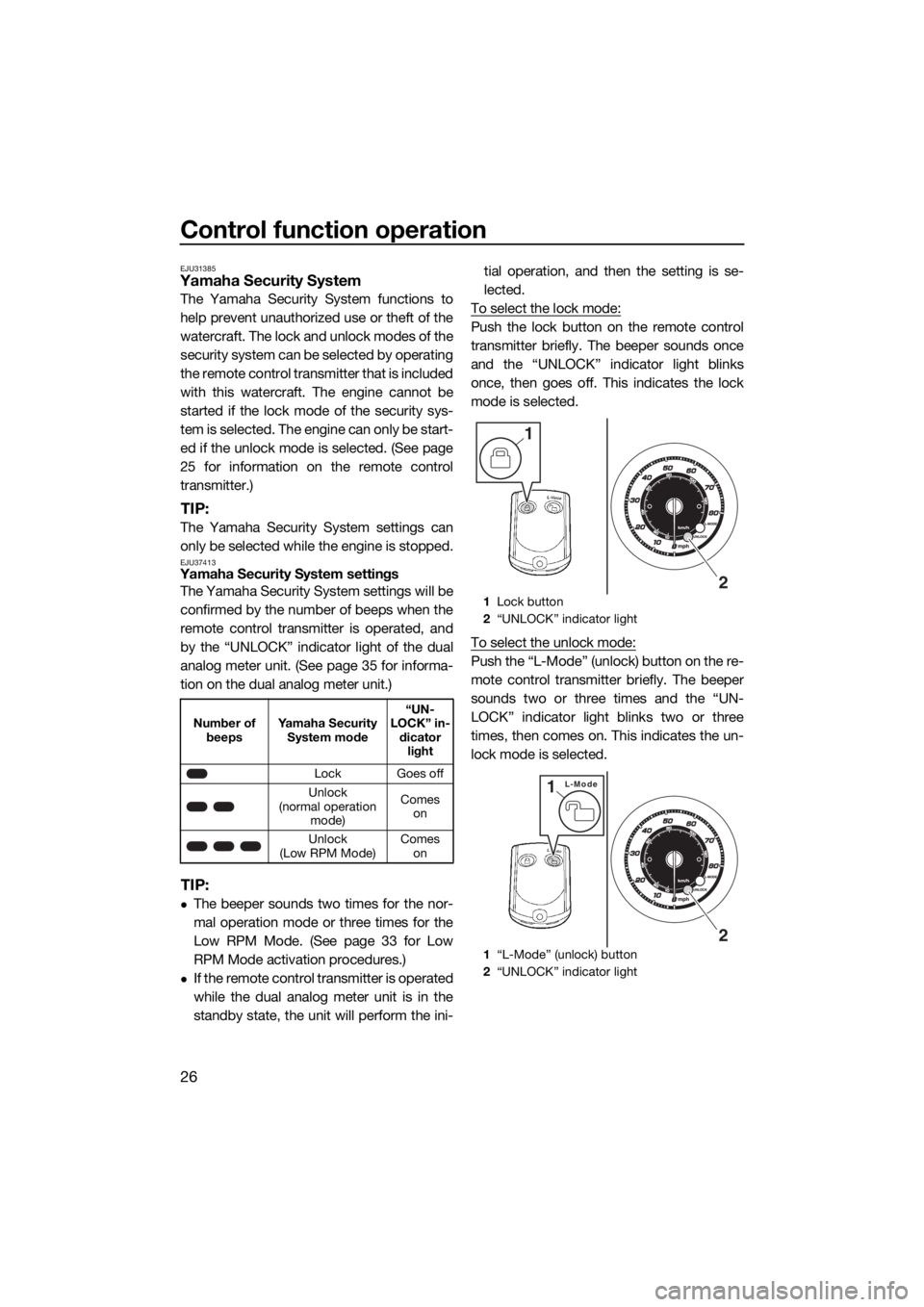
Control function operation
26
EJU31385Yamaha Security System
The Yamaha Security System functions to
help prevent unauthorized use or theft of the
watercraft. The lock and unlock modes of the
security system can be selected by operating
the remote control transmitter that is included
with this watercraft. The engine cannot be
started if the lock mode of the security sys-
tem is selected. The engine can only be start-
ed if the unlock mode is selected. (See page
25 for information on the remote control
transmitter.)
TIP:
The Yamaha Security System settings can
only be selected while the engine is stopped.
EJU37413Yamaha Security System settings
The Yamaha Security System settings will be
confirmed by the number of beeps when the
remote control transmitter is operated, and
by the “UNLOCK” indicator light of the dual
analog meter unit. (See page 35 for informa-
tion on the dual analog meter unit.)
TIP:
The beeper sounds two times for the nor-
mal operation mode or three times for the
Low RPM Mode. (See page 33 for Low
RPM Mode activation procedures.)
If the remote control transmitter is operated
while the dual analog meter unit is in the
standby state, the unit will perform the ini-tial operation, and then the setting is se-
lected.
To select the lock mode:
Push the lock button on the remote control
transmitter briefly. The beeper sounds once
and the “UNLOCK” indicator light blinks
once, then goes off. This indicates the lock
mode is selected.
To select the unlock mode:
Push the “L-Mode” (unlock) button on the re-
mote control transmitter briefly. The beeper
sounds two or three times and the “UN-
LOCK” indicator light blinks two or three
times, then comes on. This indicates the un-
lock mode is selected.
Number of
beepsYamaha Security
System mode“UN-
LOCK” in-
dicator
light
Lock Goes off
Unlock
(normal operation
mode)Comes
on
Unlock
(Low RPM Mode)Comes
on
1Lock button
2“UNLOCK” indicator light
1“L-Mode” (unlock) button
2“UNLOCK” indicator light
1
2
L-Mode1
2
UF3L71E0.book Page 26 Monday, June 30, 2014 9:06 AM
Page 33 of 104
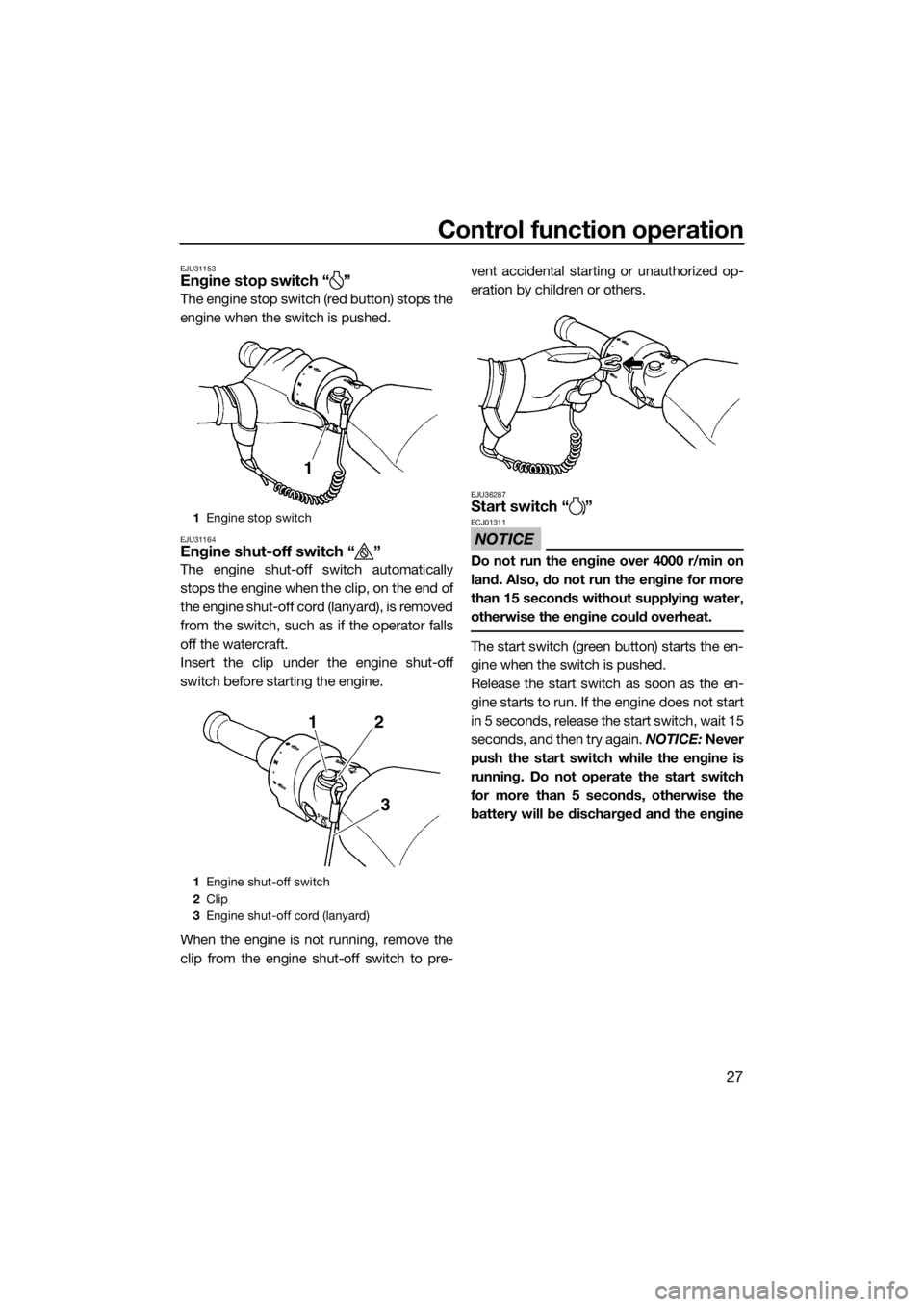
Control function operation
27
EJU31153Engine stop switch “ ”
The engine stop switch (red button) stops the
engine when the switch is pushed.
EJU31164Engine shut-off switch “ ”
The engine shut-off switch automatically
stops the engine when the clip, on the end of
the engine shut-off cord (lanyard), is removed
from the switch, such as if the operator falls
off the watercraft.
Insert the clip under the engine shut-off
switch before starting the engine.
When the engine is not running, remove the
clip from the engine shut-off switch to pre-vent accidental starting or unauthorized op-
eration by children or others.
EJU36287Start switch “ ”
NOTICE
ECJ01311
Do not run the engine over 4000 r/min on
land. Also, do not run the engine for more
than 15 seconds without supplying water,
otherwise the engine could overheat.
The start switch (green button) starts the en-
gine when the switch is pushed.
Release the start switch as soon as the en-
gine starts to run. If the engine does not start
in 5 seconds, release the start switch, wait 15
seconds, and then try again. NOTICE: Never
push the start switch while the engine is
running. Do not operate the start switch
for more than 5 seconds, otherwise the
battery will be discharged and the engine
1Engine stop switch
1Engine shut-off switch
2Clip
3Engine shut-off cord (lanyard)
1
2
1
3
UF3L71E0.book Page 27 Monday, June 30, 2014 9:06 AM
Page 36 of 104

Control function operation
30
TIP:
It will take about 60 seconds for the water
to reach the outlets after the engine is start-
ed.
Water discharge may not be constant
when the engine is running at idling speed.
If this occurs, apply a little throttle to make
sure that water discharges properly.
EJU40323Water separator
The water separator prevents water from en-
tering the fuel tank by collecting any water
that has entered the fuel tank breather hose if
the watercraft was capsized.
If water has collected in the water separator,
drain it by loosening the drain screw.
To drain water from the water separator:
(1) Place a drain pan or dry cloth under the
water separator.(2) Gradually loosen the drain screw to drain
the water. Catch the draining water in the
drain pan or soak it up with the dry cloth
so that it does not spill into the engine
compartment. If any water spills into the
watercraft, be sure to wipe it up with a
dry cloth.
(3) Securely tighten the drain screw until it
stops.
1Water separator
1Drain screw
1
1
UF3L71E0.book Page 30 Monday, June 30, 2014 9:06 AM
Page 37 of 104

Watercraft operation
31
EJU40013
Watercraft operation functions
EJU37183Reverse system
WARNING
EWJ01231
Do not use the reverse function to slow
down or stop the watercraft as it could
cause you to lose control, be ejected, or
impact the handlebars.
Make sure that there are no obstacles or
people behind you before shifting into
reverse.
Do not touch the reverse gate while the
shift lever is being operated, otherwise
you could be pinched.
When the shift lever is moved to the reverse
position, the reverse gate lowers and deflects
the water jet being discharged from the jet
thrust nozzle. This allows the watercraft to
move in reverse.
To shift into reverse:
(1) Release the throttle lever and let the en-
gine speed return to idle.
(2) Pull the shift lever rearward until it stops
in the reverse position. The reverse gatewill lower and the watercraft will start
moving in reverse at trolling speed.
TIP:
This model is equipped with a function which
limits the engine speed in reverse.
To shift into forward:
(1) Release the throttle lever and let the en-
gine speed return to idle.
(2) Push the shift lever forward until it stops
in the forward position. The reverse gate
will rise and the watercraft will start mov-
ing forward at trolling speed.
1Shift lever
2Reverse position
3Forward position
1Reverse gate
2Forward position
3Reverse position
3 2 1
12
3
UF3L71E0.book Page 31 Monday, June 30, 2014 9:06 AM
Page 41 of 104
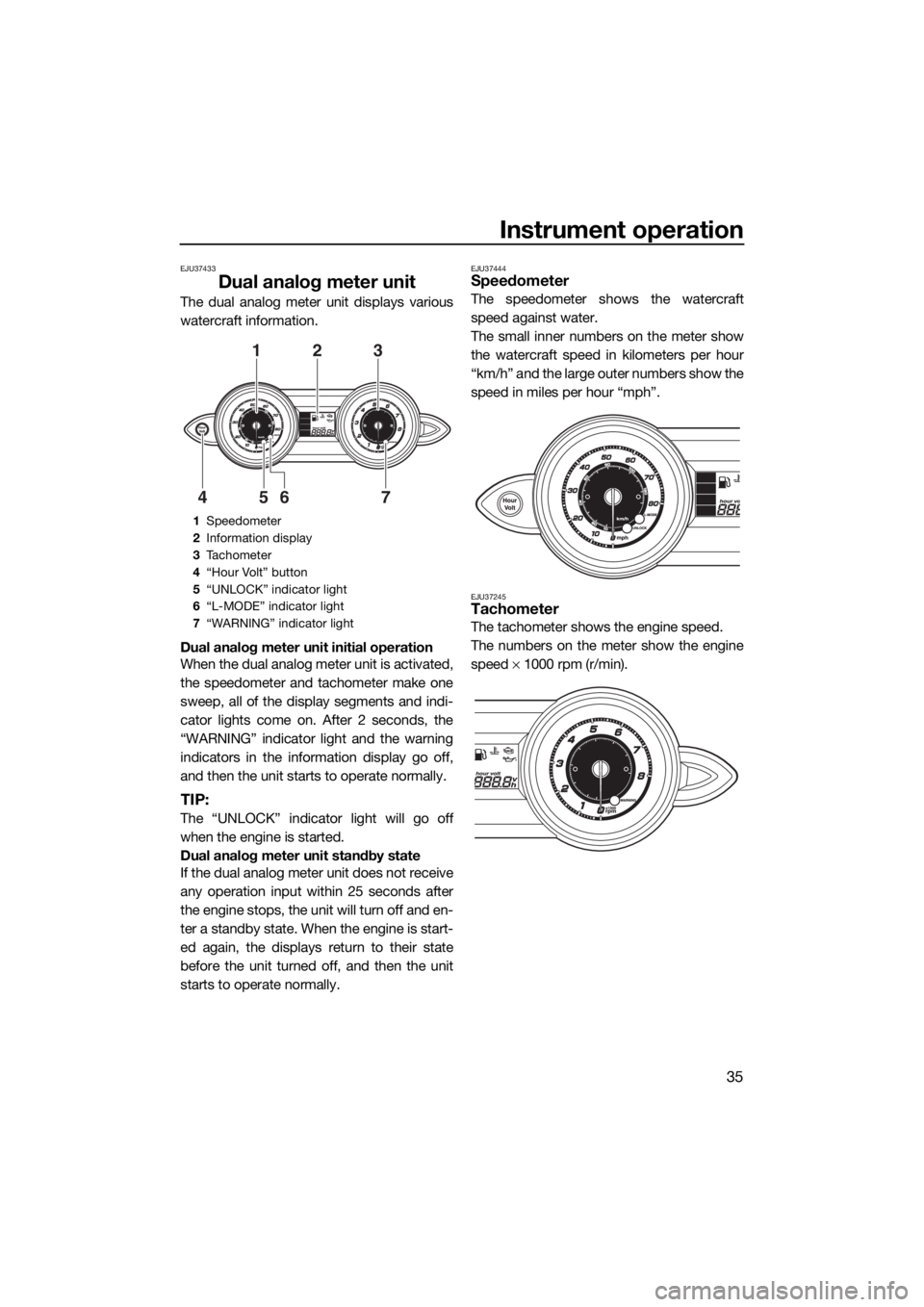
Instrument operation
35
EJU37433
Dual analog meter unit
The dual analog meter unit displays various
watercraft information.
Dual analog meter unit initial operation
When the dual analog meter unit is activated,
the speedometer and tachometer make one
sweep, all of the display segments and indi-
cator lights come on. After 2 seconds, the
“WARNING” indicator light and the warning
indicators in the information display go off,
and then the unit starts to operate normally.
TIP:
The “UNLOCK” indicator light will go off
when the engine is started.
Dual analog meter unit standby state
If the dual analog meter unit does not receive
any operation input within 25 seconds after
the engine stops, the unit will turn off and en-
ter a standby state. When the engine is start-
ed again, the displays return to their state
before the unit turned off, and then the unit
starts to operate normally.
EJU37444Speedometer
The speedometer shows the watercraft
speed against water.
The small inner numbers on the meter show
the watercraft speed in kilometers per hour
“km/h” and the large outer numbers show the
speed in miles per hour “mph”.
EJU37245Tachometer
The tachometer shows the engine speed.
The numbers on the meter show the engine
speed × 1000 rpm (r/min).
1Speedometer
2Information display
3Tachometer
4“Hour Volt” button
5“UNLOCK” indicator light
6“L-MODE” indicator light
7“WARNING” indicator light
123
7 6 5 4
UF3L71E0.book Page 35 Monday, June 30, 2014 9:06 AM
Page 43 of 104
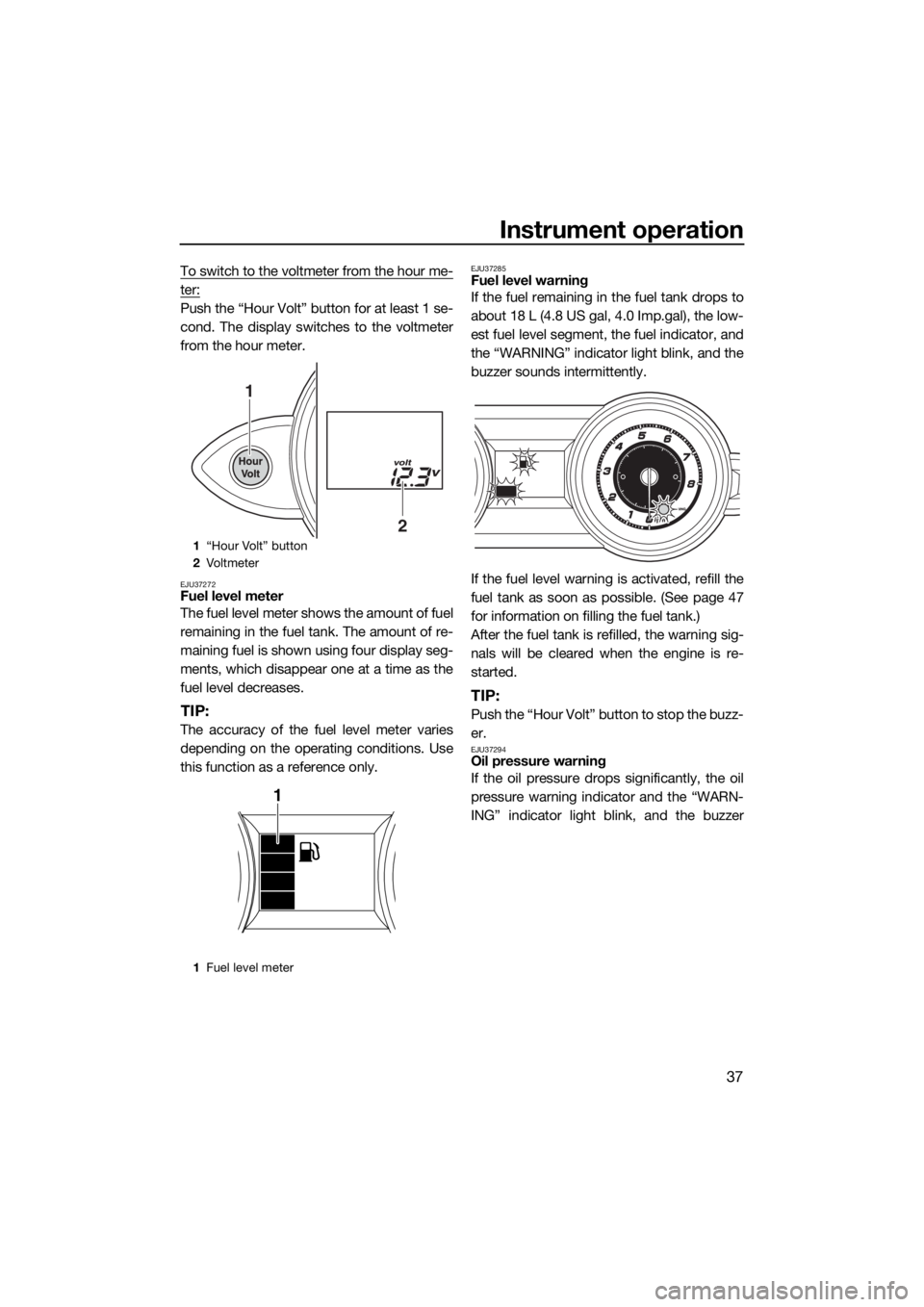
Instrument operation
37
To switch to the voltmeter from the hour me-
ter:
Push the “Hour Volt” button for at least 1 se-
cond. The display switches to the voltmeter
from the hour meter.
EJU37272Fuel level meter
The fuel level meter shows the amount of fuel
remaining in the fuel tank. The amount of re-
maining fuel is shown using four display seg-
ments, which disappear one at a time as the
fuel level decreases.
TIP:
The accuracy of the fuel level meter varies
depending on the operating conditions. Use
this function as a reference only.
EJU37285Fuel level warning
If the fuel remaining in the fuel tank drops to
about 18 L (4.8 US gal, 4.0 Imp.gal), the low-
est fuel level segment, the fuel indicator, and
the “WARNING” indicator light blink, and the
buzzer sounds intermittently.
If the fuel level warning is activated, refill the
fuel tank as soon as possible. (See page 47
for information on filling the fuel tank.)
After the fuel tank is refilled, the warning sig-
nals will be cleared when the engine is re-
started.
TIP:
Push the “Hour Volt” button to stop the buzz-
er.
EJU37294Oil pressure warning
If the oil pressure drops significantly, the oil
pressure warning indicator and the “WARN-
ING” indicator light blink, and the buzzer
1“Hour Volt” button
2Vo l t m et e r
1Fuel level meter
1
2
1
UF3L71E0.book Page 37 Monday, June 30, 2014 9:06 AM
Page 57 of 104
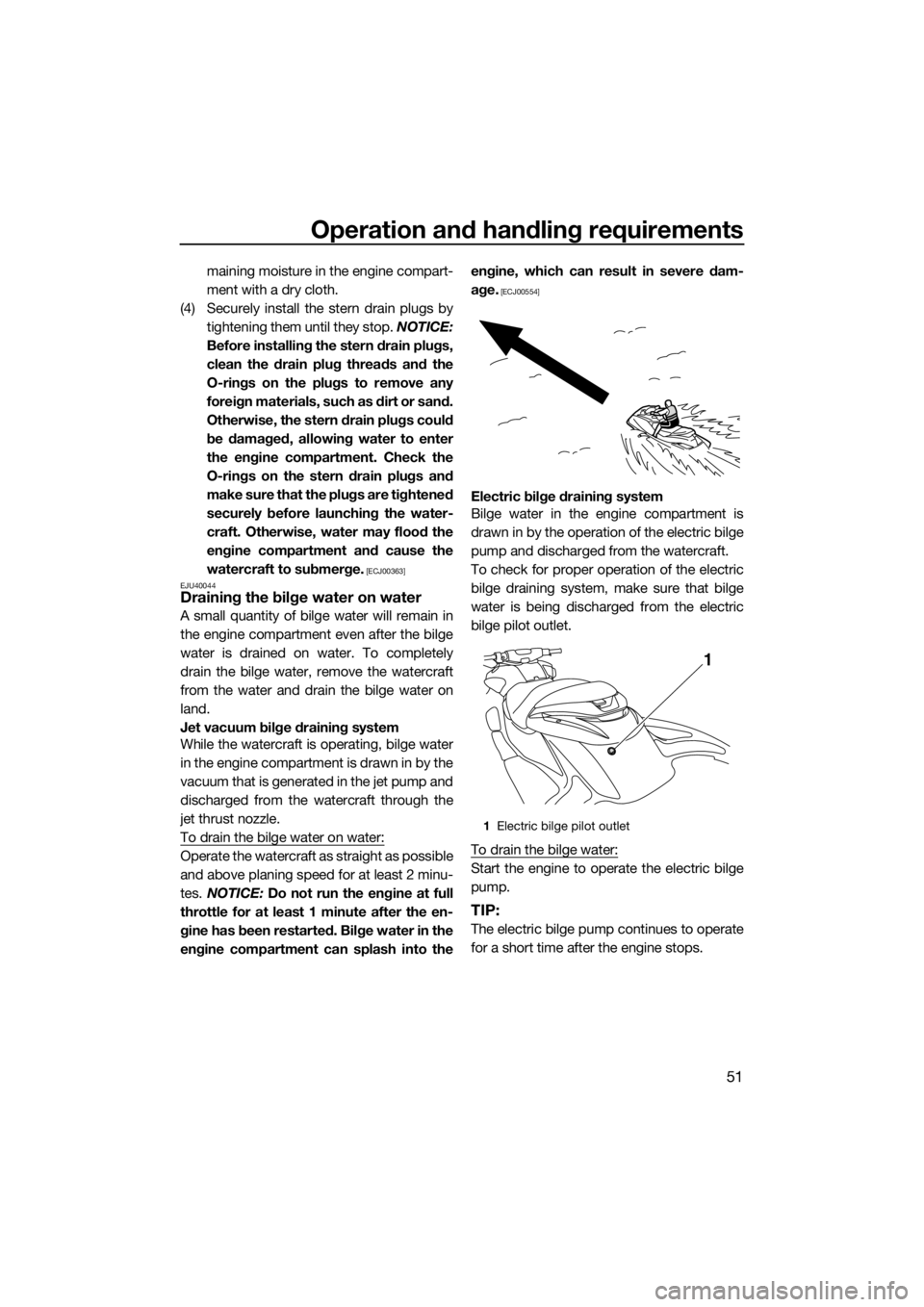
Operation and handling requirements
51
maining moisture in the engine compart-
ment with a dry cloth.
(4) Securely install the stern drain plugs by
tightening them until they stop. NOTICE:
Before installing the stern drain plugs,
clean the drain plug threads and the
O-rings on the plugs to remove any
foreign materials, such as dirt or sand.
Otherwise, the stern drain plugs could
be damaged, allowing water to enter
the engine compartment. Check the
O-rings on the stern drain plugs and
make sure that the plugs are tightened
securely before launching the water-
craft. Otherwise, water may flood the
engine compartment and cause the
watercraft to submerge.
[ECJ00363]
EJU40044
Draining the bilge water on water
A small quantity of bilge water will remain in
the engine compartment even after the bilge
water is drained on water. To completely
drain the bilge water, remove the watercraft
from the water and drain the bilge water on
land.
Jet vacuum bilge draining system
While the watercraft is operating, bilge water
in the engine compartment is drawn in by the
vacuum that is generated in the jet pump and
discharged from the watercraft through the
jet thrust nozzle.
To drain the bilge water on water:
Operate the watercraft as straight as possible
and above planing speed for at least 2 minu-
tes. NOTICE: Do not run the engine at full
throttle for at least 1 minute after the en-
gine has been restarted. Bilge water in the
engine compartment can splash into theengine, which can result in severe dam-
age.
[ECJ00554]
Electric bilge draining system
Bilge water in the engine compartment is
drawn in by the operation of the electric bilge
pump and discharged from the watercraft.
To check for proper operation of the electric
bilge draining system, make sure that bilge
water is being discharged from the electric
bilge pilot outlet.
To drain the bilge water:
Start the engine to operate the electric bilge
pump.
TIP:
The electric bilge pump continues to operate
for a short time after the engine stops.
1Electric bilge pilot outlet
1
UF3L71E0.book Page 51 Monday, June 30, 2014 9:06 AM